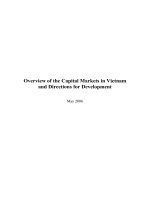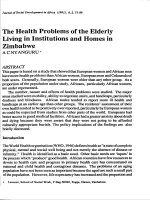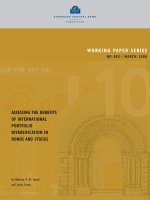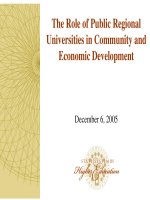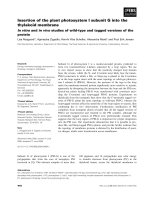THE INVESTIGATION ABOUT THE SUCCESS OF THE SAFETY BUS IN TYNE AND WEAR UNIVERSITY (TWU) potx
Bạn đang xem bản rút gọn của tài liệu. Xem và tải ngay bản đầy đủ của tài liệu tại đây (553.32 KB, 46 trang )
BM0421
BUSINESS
RESEARCH
ANALYSIS
Tutor: Dr. Ian Charity
Words count: 3,218 words
PROGRAMME: MSc of Business with Hospitality and Tourism Management
P a g e | 2
P a g e | 3
!"#$%%&""'"%(")'%"%$
* ""&&%!+#
The questionnaire (survey) is a useful tool for Tyne and Wear University
(TWU) to access and justify the success of the safety bus. In order to collect the
greatest number of respondents with accurate response, the university need to
design and distribute the effective questionnaire.
The reason for choosing the questionnaire is caused by several advantages it
brings to the business. According to Robson, Pemberton and McGrane (2011), the
questionnaire seems to cover a numerous people, so, it increases the sample size.
Moreover, the highly targeted of chosen sample is planned and provides the very
affordable cost in printing and distributing the questionnaire to chosen respondents.
Due to Bryman (2008), the critical factor which leads to the efficiency of the
questionnaire is that is gives the respondents time to think and justify their suitable
answer due to the absence of the interview bias. The sample size should not very
large but not very small because it will bring some limitations to the investigators in
term of the results are not cover the aims of the business or too wide to conclude the
status of the strategy. Therefore, TWU targets the random sample size is 1000
students in overall of 3500 students. The postal method will support the TWU in
saving time and expenditures for distributing the questionnaire in various ways.
Together with the advantages, there are also some disadvantages which need
to be take in account such as just few people would like to spend time and find
interested in filling in the questionnaire delivered to them (Walonick, 2004). This
caused the ineffective in the responses of respondents will be low. Moreover, without
the explanations from the distributors, it might lead to the misunderstood and made
the inaccuracy of the survey (Wilson and McLean, 1994).
,* )'%"%$ "
The questionnaire plays a critical role towards the quality of the survey, in term of
P a g e | 4
providing an accurate and good quality questionnaire; any single question should be
considered and planned before concluding to write down (Brace, 2008). Due to
Hague (1993), the questionnaire should be relevant to the research objectives in
term of while collecting the data from respondents, it also help to address the
business issue. Thus, it is very important to identify what information areas the
questionnaire needs to cover.
The aim of TWU is to assess the success of the Safety Bus by gathering the
information of students through the questionnaire about feeling and experiences of
crime. Based on that, the structure of the questionnaire should be designed includes
of: background information (gender, age and country of origin); evaluation of
respondents towards their feeling in donation, quality of safety bus, and
recommendations/ comments/ suggestions on how the programs could be include
and improve in the future (Brace, 2008)
-* )'%"%$$'&'$"#./(0'%
As it had been discussed above that the structure of the questionnaire will be
concluded 4 parts: background information (gender, age and country of origin);
evaluation of respondents towards their feeling in donation, quality of safety bus, and
recommendations/ comments/ suggestions on how the programs could be include
and improve in the future. The good structure of questionnaire will demonstrate the
ensuring of covering all topics relevant to the research and respondents (Peterson,
2000). As the designer for the questionnaire, it has to be ensure that each question
is read and considered by the respondents is easy to understand and avoid the
confusing of multiple answers or information (Lewis and Thornill, 2003). Moreover,
the business always puts their ambiguous into the questionnaire to assess and reach
more information from the respondents to understand their expectations, but, Wilson
and McLean (1994) suggest that question must be easy to understand and
unambiguous.
Furthermore, according Bryman (2008), questions should be organized from
dichotomous questions, multiple choice questions to open-ended questions following
to the level of difficulty. In addition, the question should be too short or too long in
order to motivate and encourage the respondents to read and fulfil the questionnaire
with the best answer. Foddy (1994) suggests that the content, grammar and spelling
of questions should be considered carefully to reach the study’s objective and show
P a g e | 5
the respect to the respondents.
1* )'%"%$2
There are two main types of question are open-ended and closed questions
(Robson, Pemberton and McGrane (2011). The various of questionnaire will help the
study utilize the potential answering abilities of respondents in term of using mix of
question types is important to make the questionnaire more interesting, easier and
significantly raise respond.
As the dean’s expectation to target a large number of respondents, almost of the
question are closed. However, the questionnaire also includes one open question
which would be useful get addition comments and explanations. Thus, on the one
hand it is easy for the respondent to answer. Besides, quantitative data could be
analyzed straightforwardly. On the other hand, the data is still detail and potential
(Robson, 2011).
Furthermore, the answers are designed using numerical scales. The answers for
almost of the closed questions are balanced between positive and negative
response. As the intention not to force respondent to choose positively, the option of
neutral response is available. In addition, there is also the option to answer “not
applicable”. Thus, it would not exclude any possible opinion.
The questions for demographic information are design to be multiple choice
questions or dichotomous questions where only two answer. These types of question
are easy to answer because the ranges of answers are presented. In fact, that
simplicity also influences people willingness to response to the questionnaire (Web,
2000).
Andrews (2003) discussed that the questionnaires should be ended by open-
ended questions because it will allow the respondents to show their expectations or
understanding and feelings about the questionnaire. But instead, this type of
question is difficult for the analyst to coding, analysing and interpreting data. There
should be an open-ended question in the survey of TWU to investigate the
perceptions/ expectations or thinking of the respondents.
3* #%4 "
Coding plan is the collection of responses and convert these responses into
numbers or code. Lewis and Thornill (2003) stated that responses on the survey
P a g e | 6
need to be coded before data entered for analysis into the SPSS software. The
coding plan helps the researcher to track the respondents who complete the
questionnaire
Robson, Pemberton and McGrane (2011) claim that an ‘official use’ column
should be involved in the right hand side of the questionnaire format. This column
supports the researchers to code the responses to each of the questions into the
SPSS.
5* %"6%%2(%$'&%
The reliability and validity of using this questionnaire is also considered when
establishing. Firstly, there are a number of initial considerations are taken into
account, particularly the nature of respondents, the type of method being used to
survey. Rattray and Jones (2005) asserted that, because among many ranges of
scales and responses, choosing one particular one would results different type and
level of data. This structure’s association with appropriate coding plan would make
the results reliable.
7* ! %&"%( "#""&&%
As it had been discussed above that the method of data collection and
distribution of this research is postal survey, thus, as Robson et al (2011, p.50),
“postal surveys is one of the most accepted, valued and applied methods for
collecting survey data in business research”.
The reason for choosing this method rather than mail survey is because of postal
survey does not require a significant cost but also efficiency in time management by
the time between dispatch and return is flexible and comfortable enough for the
respondents to spend couples time on it and get it done accurately (Robson, 2011).
However, the post survey also finds that the rate of response from the
respondents is lower. It is normally around 39.2% as the result of TWU found in the
later of this research. Robson et al. (2011) discussed that this low rate can only be
enhanced by having a good questionnaire design and short time required to
complete. There is also a difficulty in providing response back to the TWU of the
respondents. The reason is the limited contact between researcher and respondents.
Thus, the questions and answers need to high level of brevity, accuracy and clarity
P a g e | 7
(Agrawal, 2009).
In general, this questionnaire is designed with the sufficient characteristics as
to achieve the objective of ensuring a high response rate and highly reliability.
Besides, its questions flow and structure is also appropriate to do the interpretation.
Moreover, its accuracy, brevity and clarity could definitely help TWU to achieve
survey expectation.
P a g e | 8
"$,"""2%"#"'"%
* $%/('#86"&94$'#%($!"%
Gender
Gender Male Female Total
Frequency 177 215 392
Percentage 45.2% 54.8% 100%
The graph indicates that student’s gender Normal Distribution, which
theoretically have a distinctive shape.
The table presented that 45.2% of male responded the questionnaire within
392 respondents. That ratio is similar to the proportion of male students at TWU and
considered as less than the number of female. Moreover, out – of 1000 delivered
questionnaires, TWU received 392 responses, which accumulated 39.2% students
participated from in this survey.
Hence, the rate of male respondents hardly becomes representative of
population who resent their answers to school.
P a g e | 9
Descriptives
Statistic Std. Error
Gender Mean 1.55 .025
95% Confidence
Interval for Mean
Lower Bound 1.50
Upper Bound 1.60
5% Trimmed Mean 1.55
Median 2.00
Variance .248
Std. Deviation .498
Minimum 1
Maximum 2
Range 1
Interquartile Range 1
Skewness 196 .123
Kurtosis -1.972 .246
This table showed that the skewness accounted for -0.196 and the kurtosis is
-1.972 which represent symmetrical shaped. The mean was pointed at 1.55 is
different median getting at 2.00 and the standard deviation is 0.498. As a result, the
mean of population was arranged in an interval of 1.50 and 1.60.
Origin
Origin UK EU International Total
Frequency 311 29 52 392
Percentage 79.3% 7.4% 13.3% 100%
P a g e | 10
The table and diagram showed that from 392 results achieved from students,
there are 79.3% respondents from UK, 7.4% of those come from EU and the others
are international is calculated at 13.3%.
P a g e | 11
Descriptives
Statistic Std. Error
Origin Mean 1.34 .035
95% Confidence Interval
for Mean
Lower Bound 1.27
Upper Bound 1.41
5% Trimmed Mean 1.27
Median 1.00
Variance .491
Std. Deviation .701
Minimum 1
Maximum 3
Range 2
Interquartile Range 0
Skewness 1.753 .123
Kurtosis 1.347 .246
There is a great different between the mean and the median given by the
amount of 1.34 and 1 respectively. The skewness is positively equal to 1.753 higher
than 1.
Therefore, the proportion of origin of students is drawn in asymmetric shape.
In addition, the mean in the table 4 ranges from 1.27 to 1.41.
Postcode
Postcode NX1 NX2 NX3 NX4 Other Total
Frequency 44 161 46 100 41 392
Percentag
e
11.2% 41.1% 11.7% 25.5% 10.5% 100%
P a g e | 12
The majority of first – year students (41.1%) chose NX2 as their living place
during a year whereas only 10.5% of 392 students are living in the other places
which are determined further location than TWU campus.
P a g e | 13
Descriptives
Statistic Std. Error
Postcode Mean 2.83 .062
95% Confidence
Interval for Mean
Lower Bound 2.71
Upper Bound 2.95
5% Trimmed Mean 2.81
Median 2.00
Variance 1.508
Std. Deviation 1.228
Minimum 1
Maximum 5
Range 4
Interquartile Range 2
Skewness .304 .123
Kurtosis -1.119 .246
As the result show in the table, the mean and median are constantly classified
different, particularly the mean is estimated to 2.83 while median is 2. Furthermore,
the skewness is equal to 0.304 which is positively lower than 1. Hence, it illustrates
an asymmetric skewed distribution. According to the mean of population, its range is
from 2.71 to 2.95.
* +(%4('#"6'++$"%+&%2"%4+
Frequency Percent
Valid Never 55 14.0
Occasionally 154 39.3
Often 132 33.7
Always 51 13.0
Total 392 100.0
P a g e | 14
The table showed that the highest level at 39.3% belongs to the group of
students seldom feel unsafe when travelling outside their accommodations at night.
Only 13% of students are scared to hang out at night.
The figure is inconsiderable to highlight the rate of crime in the city, some
investigates associate with gender, origin and postcode will analysed deeply about
how safe the night activities are from the point of view of students.
P a g e | 15
Descriptives
Statistic Std. Error
Threatened Mean 2.46 .045
95% Confidence
Interval for Mean
Lower Bound 2.37
Upper Bound 2.54
5% Trimmed Mean 2.45
Median 2.00
Variance .791
Std. Deviation .889
Minimum 1
Maximum 4
Range 3
Interquartile Range 1
Skewness .088 .123
Kurtosis 718 .246
As can be seen in the table, there is a slightly different between the mean of 2.46
and the median of 2. As the skewness indicates at 0.088 lower than 1, student
threatened feelings are justified asymmetric. The mean of population is in the range
of 2.37 and 2.54.
P a g e | 16
*, %4"+$"%+% 6/'#8(%4("(2
"#4#$:$%4%"# &#
In the comparison with two interferences, the chi-square test is used for
determining if the differences are found in the frequencies is meaningful or not.
Obviously, frequencies are defined to be related to classification at different or
continuous variables and the numerical methods are applied in various situations
(Sprows. C.R., 1964). Therefore, the test demonstrates a normal distribution to
emphasize model. That is why Chi – square test will be utilized to investigate the
relationship between student’s feelings of safety to gender, origin and postcode.
1.2.1 Investigate the relationship between students’ feelings of safety
and gender:
The null and alternative hypothesis:
H
0
: No association exists between student gender and safe feelings
H
1
: An association exists between student gender and safe feelings
Significant level: 5%
SPSS supplied the results
Chi-Square Tests
Value df
Asymp. Sig. (2-
sided)
Pearson Chi-Square 22.129
a
3 .000
Likelihood Ratio 22.777 3 .000
Linear-by-Linear Association 19.630 1 .000
N of Valid Cases 392
a. 0 cells (.0%) have expected count less than 5. The minimum expected count is
23.03.
The table indicated that the p – value is 0.00000, approximately 0% which is
lower than 5%. Therefore, this study rejects H
0
at 5% significant level. In other words,
there is an association with student’s safe feeling and gender.
P a g e | 17
Gender * Threatened Crosstabulation
Threatened
TotalNever Occasionally Often Always
Gender Male Count 31 85 49 12 177
Expected
Count
24.8 69.5 59.6 23.0 177.0
Femal
e
Count 24 69 83 39 215
Expected
Count
30.2 84.5 72.4 28.0 215.0
Total Count 55 154 132 51 392
Expected
Count
55.0 154.0 132.0 51.0 392.0
The table above gave the as the explanation for the differences between the
pragmatic and expected account.
Female students feel threatened when they go round the city during the night
rather than male. Particularly, there are 39 females are always in the unsafe moods
while only 12 males have this emotion in their minds. Moreover, most students rarely
think that they will be attacked by the criminals at night.
P a g e | 18
1.2.2 Investigate the relationship between students’ feelings of
safety and origin:
The null and alternative hypothesis:
H
0
: No association exists between student origin and safe feelings
H
1
: An association exists between student origin and safe feelings
Significant level: 5%
SPSS supplied the results
Chi-Square Tests
Value df
Asymp. Sig. (2-
sided)
Pearson Chi-Square 7.268
a
6 .297
Likelihood Ratio 7.143 6 .308
Linear-by-Linear Association .450 1 .502
N of Valid Cases 392
a. 2 cells (16.7%) have expected count less than 5. The minimum expected count is
3.77.
The table shows that the p-value is 0.297 which is greater than 0.05.
Therefore, this research accepts the H0 at 5% significant level. It means that there is
no relationship between origin and student’s threatened feeling.
P a g e | 19
Origin * Threatened Crosstabulation
Threatened
TotalNever Occasionally Often Always
Origin UK Count 45 121 107 38 311
Expected
Count
43.6 122.2 104.7 40.5 311.0
EU Count 4 10 13 2 29
Expected
Count
4.1 11.4 9.8 3.8 29.0
Internationa
l
Count 6 23 12 11 52
Expected
Count
7.3 20.4 17.5 6.8 52.0
Total Count 55 154 132 51 392
Expected
Count
55.0 154.0 132.0 51.0 392.0
The table presented the comparison between the observed and expected
count. Due to the almost similar between practical and expected count, we accept
the H
0
as conclude that the student origin does not affect to the threat of crime at
night.
1.2.3 Investigate the relationship between students’ feelings of
safety and postcode:
The null and alternative hypothesis:
H
0
: No association exists between student postcode and safe feelings
H
1
: An association exists between student postcode and safe feelings
Significant level: 5%
SPSS supplied the results’
P a g e | 20
Chi-Square Tests
Value df
Asymp. Sig. (2-
sided)
Pearson Chi-Square 35.680
a
12 .000
Likelihood Ratio 39.727 12 .000
Linear-by-Linear Association 13.586 1 .000
N of Valid Cases 392
a. 0 cells (.0%) have expected count less than 5. The minimum expected count is
5.33.
The Chi-square test illustrates that the p – value is 0.00000, approximately
0% which is lower than 5%. Therefore, this study rejects H
0
at 5% significant level. In
other words, there is an association with student’s safe feeling and postcode.
P a g e | 21
Postcode * Threatened Crosstabulation
Threatened
TotalNever
Occasional
ly Often Always
Postcod
e
NX1 Count 8 21 13 2 44
Expected
Count
6.2 17.3 14.8 5.7 44.0
NX2 Count 31 68 48 14 161
Expected
Count
22.6 63.3 54.2 20.9 161.0
NX3 Count 4 14 20 8 46
Expected
Count
6.5 18.1 15.5 6.0 46.0
NX4 Count 3 42 33 22 100
Expected
Count
14.0 39.3 33.7 13.0 100.0
Other Count 9 9 18 5 41
Expected
Count
5.8 16.1 13.8 5.3 41.0
Total Count 55 154 132 51 392
Expected
Count
55.0 154.0 132.0 51.0 392.0
Moreover, as the result in the table above gave the explanation about the
differences between the observed and expected account. Students who are living in
NX4 feel to be the most threatened when they go round the city during the night
rather than the others. For those who accommodate in NX2 normally feel safe when
travelling at night. Moreover, most students rarely think that they will be attacked by
the criminals at night.
,*$%/(+&+"$"&$%%&("(2''$
2.1 Number – Users:
P a g e | 22
The distribution of number of usages rating is normal distribution with
asymmetrical shape with the skewness of 0.538. Furthermore, the mean of 2.96 and
the median of 3 are not much different. The standard deviation is 1.845, therefore;
the mean of population is between 2.77 and 3.14 at 95% confident interval.
Descriptives
Statistic Std. Error
No_Uses Mean 2.96 .093
95% Confidence Interval for
Mean
Lower Bound 2.77
Upper Bound 3.14
5% Trimmed Mean 2.89
Median 3.00
Variance 3.402
Std. Deviation 1.845
Minimum 0
Maximum 10
Range 10
Interquartile Range 2
Skewness .538 .123
Kurtosis .379 .246
P a g e | 23
2.2 Distance from term-time accommodation to TWU Union
Descriptives
Statistic Std. Error
Distance_Home Mean 4.755 .1501
95% Confidence Interval
for Mean
Lower Bound 4.460
Upper Bound 5.050
5% Trimmed Mean 4.476
Median 4.050
Variance 8.827
Std. Deviation 2.9710
Minimum .8
Maximum 20.0
Range 19.2
Interquartile Range 3.5
Skewness 1.796 .123
Kurtosis 4.838 .246
The table showed that the skewness positively equals to 1.796, hence, the
distribution of characteristic of safety bus users about distance from term-time
accommodation to TWU Union is positive skewed where the long tail moved to
significantly on the right of the distribution, which is expressed in figure 6. The mean
P a g e | 24
of 4.755 and the median of 4.050 made the distribution have asymmetric shape. The
standard deviation is 2.9710 leads to the mean of population range from 4.46 to 5.05
at 95% confidence interval.
P a g e | 25
2.3 Distance from term-time accommodation to nearest public transport
Descriptives
Statistic
Std.
Error
Distance_Publi
c
Mean .889 .0287
95% Confidence
Interval for Mean
Lower Bound .833
Upper Bound .946
5% Trimmed Mean .840
Median .700
Variance .322
Std. Deviation .5675
Minimum .1
Maximum 3.4
Range 3.3
Interquartile Range .6
Skewness 1.430 .123
Kurtosis 2.471 .246
The table showed that the skewness positively equals to 1.430, hence, the
distribution of characteristic of safety bus users about distance from term-time
accommodation to nearest public transport is positive skewed where the long tail
moved to significantly on the right of the distribution, which is expressed in figure 7.
The mean of 0.889 and the median of 0.7 is quiet similar, which made the distribution



